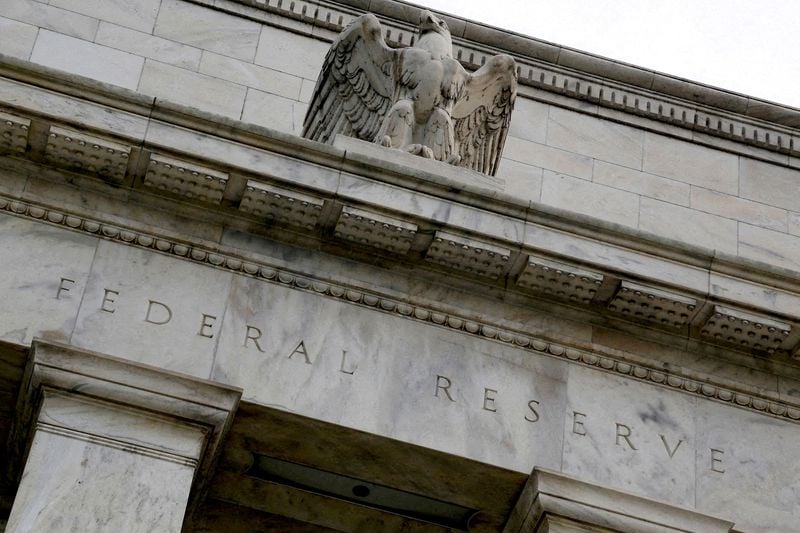By Michael S. Derby
NEW YORK (Reuters) – Two Federal Reserve regional bank measures that map bond yields to the economic outlook still put better-than-even chances of a U.S. recession by next year, even as recent gauges of activity in everything from consumer spending to hiring show little evidence of a pending slowdown.
A Cleveland Fed measure updated on Thursday now sees a 62.7% chance of a downturn by February 2024, a slight moderation from the 63.3% probability seen a month ago, but still well above the 53.8% probability in December. Meanwhile, a New York Fed measure, updated earlier this month, flags a 57.1% recession probability by January 2024, up from the 47.3% chance seen in December.
The two gauges arrived amid ongoing concern that the U.S. central bank’s historically aggressive campaign of interest rate rises could send the economy into a downturn. The pace of that campaign, which has lifted the Fed’s benchmark overnight interest rate from near zero last March to the current 4.50%-4.75% range, isn’t done. More increases are likely into the summer.
Both models divine their message from the state of the U.S. government bond yield curve. Since October, the yield on the 3-month Treasury bill has been higher than that of the 10-year Treasury note, an atypical state of affairs that forms what’s called a yield-curve inversion. Normally, yields on longer-dated securities are higher than those for shorter maturities to compensate for increased long-term investment risks.
Inverted yield curve conundrum https://www.reuters.com/graphics/USA-ECONOMY/lbvgglonovq/chart.png
Inversions are a key Wall Street talisman because they frequently appear before economic downturns, even as there is no settled explanation as to whether the phenomenon is a genuine signal of a downturn or simply correlates with recession.
Another commonly tracked measure – the spread between 2-year and 10-year Treasury notes – has been inverted for even longer, but San Francisco Fed economists have identified the 3-month versus 10-year spread as having the stronger relationship with recessions. The gap grew to as wide as -132 basis points last month but has since narrowed to about -97.
Fed officials have said so far that they see slow growth this year and no recession, although a number of policymakers view it as a real risk. Recent data, however, has found the economy unexpectedly resilient in the face of the monetary policy tightening, a development that could force the Fed to be even more aggressive with future rate rises.
Indeed, after job growth in January was far above expectations, Citigroup’s U.S. Economic Surprise Index, which measures the degree to which each new report exceeds or trails economists’ forecasts, shot to its highest in 10 months and remains near there. And recent surveys of economists have shown reduced expectations of a recession.
Meanwhile, the U.S. government released data on Friday that showed continued inflation pressure, with the Fed’s preferred price pressure gauge, the Personal Consumption Expenditures price index, rising 5.4% in January from the same month a year ago, versus the 5.3% year-over-year reading in December. Consumer spending on a month-on-month basis in January also was up the most in nearly two years.
U.S. economy shows ‘surprising’ strength https://www.reuters.com/graphics/USA-ECONOMY/xmvjknlgqpr/chart.png
THIS TIME DIFFERENT?
Central bankers have expressed skepticism about the yield curve inversion for some time. Some see bond yields as caught between responding to the Fed’s interest rate policy and what they argue is the market’s confidence that the central bank will eventually get inflation under control. Expectations for tighter policy have pushed up short-term yields while to some degree anchoring longer-term yields more sensitive to the inflation outlook.
“That is a plausible explanation,” Philadelphia Fed President Patrick Harker said in a interview earlier this month. “I wouldn’t say it’s the only one, but to me that seems plausible.”
Cleveland Fed President Loretta Mester told reporters last week, “I always have been a little bit cautious about the yield curve indicators,” but added “there’s definitely a correlation there” with future economic activity.
Mester said that while she doesn’t see a recession on the horizon, many of her business contacts do. But she also agrees with Harker that the curve could just be reflecting the unusual circumstances of monetary policy right now.
Some Wall Street economists agree with the Fed’s view.
A recent note from J.P. Morgan economists argued the structure of interest rates is currently heavily dominated by expectations high inflation will eventually fall. Around the same time, Goldman Sachs economists wrote the inversion is not driven by recession fears but from low long-term rates adjusted for inflation.
The Fed’s own internal approach to making sense of the economic implications of the yield curve remains unsettled.
A paper by Fed Board economists last year downplayed the implications of inversion. “It is not valid to interpret inverted term spreads as independent measures of impending recession,” it said, adding that market pricing mostly reflects expectations for the path of monetary policy, with little direct thinking on the economic outlook.
(Reporting by Michael S. Derby; Editing by Dan Burns and Paul Simao)
